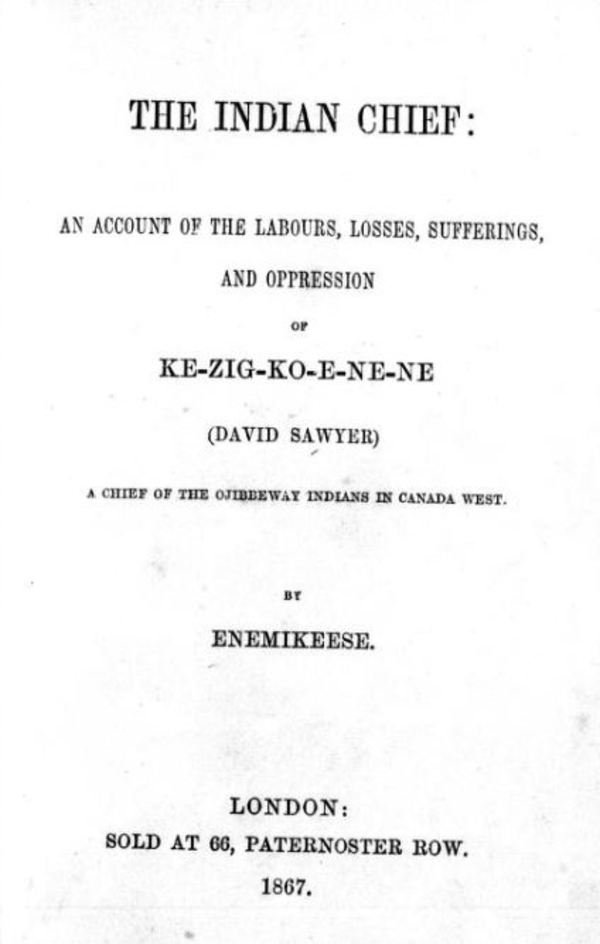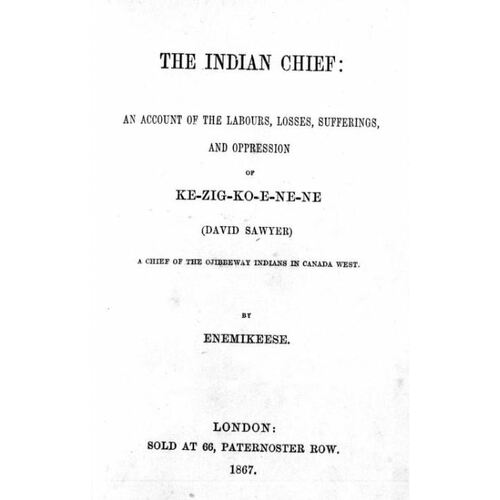
Source: Link
KEZHEGOWINNINNE (Geezhigo-w-ininih, Kezigkoenene, Kishigowininy, literally skyman, man of the sky, or one who is exalted; also known as David Sawyer), Ojibwa chief, member of the Eagle totem, Methodist lay preacher, teacher, and farmer; b. probably in 1812 at the head of Lake Ontario in Upper Canada, eldest son of Chief Joseph Sawyer [Nawahjegezhegwabe*] and his wife Wetosy (Jane); m. probably in 1830 Anna Springer, and they had at least three sons and one daughter; d. 11 Nov. 1889 at the New Credit Reserve, Tuscarora Township, Ont.
Kezhegowinninne grew up during a period of crisis for his people, the Credit band of Mississaugas (Ojibwas). Having ceded almost all of their land to the British crown, the band wandered aimlessly in search of ever-diminishing reserves of fish and game. The ranks of the Ojibwas had been reduced by European diseases, such as smallpox and tuberculosis, against which they had no natural immunity. Their numbers on the northwest shore of Lake Ontario, over 500 in 1787, had fallen to approximately 200 by 1819. Many members of the tribe believed it would soon be extinct.
In the early 1820s the band’s fortunes dramatically improved. Peter Jones [Kahkewaquonaby*] was converted to Methodism in 1823 and the following year returned to his mother’s people to preach the gospel. Conversion to Christianity not only offered hope to the dispirited band but also aided in the adoption of a new life-style based on farming and education in the ways of the white man. One of Jones’s first converts was his cousin, Kezhegowinninne, who in 1825 was baptized as David Sawyer by the Reverend Alvin Torry and thus entered the Methodist Episcopal Church (after 1833 he was in the Wesleyan Methodist Church) to which he would devote his life. Once he had accepted Christianity Sawyer immediately brought his parents to the Grand River Reserve where they too became part of the growing Indian Church. The Sawyers settled in the Methodist Indian village which was being built at the mouth of the Credit River during the winter of 1825–26 and David attended the mission school taught by John Jones [Thayendanegea*], brother of Peter.
By the late 1820s Peter Jones had persuaded almost all the band to become Christians. After he finished school Sawyer became one of his most trusted assistants. In July 1829 he received his first appointment as a teacher at the Lake Simcoe mission school and the following year he was stationed at the Methodist school for the Matchedash band on Georgian Bay. He also acted as an interpreter for the white Methodist missionary in the area and occasionally preached to the Indians in Ojibwa. In the summer of 1832, Sawyer and two members of the Credit band were entrusted with a special mission to the Indians around Sault Ste Marie. Sawyer’s journal of the trip, later translated in the Christian Guardian, is a fascinating document describing the hardships they had to overcome: “An Indian is not at a loss what to do in whatever condition he is in,” wrote Sawyer with pride. In 1833 he was sent to the Saugeen settlement on Lake Huron and the following year, pleased with his work, the church dispatched him to Muncey in Middlesex County. At both missions Sawyer acted as a teacher and an interpreter for the white missionary. After two years at Muncey he returned to the Credit Mission, where the band council immediately voted to appoint him as their paid employee.
From the limited documentary evidence that has survived Sawyer appears to have been a capable and highly independent individual. A devoted Methodist, he attacked any preacher he considered too lax in spreading the gospel. On one occasion in 1840 he told the Credit band council that he “saw no difference between the British and Canadian [Methodist preachers] . . . they love ease and were afraid to go into the backwoods for fear [of] wetting their feet.” He was equally severe towards Indians whom he felt did not make an honest attempt at farming. In a letter to Peter Jones on 1 May 1849, Sawyer stated that “if the place did literally flow with milk and honey, it would not keep some of them [the Indians] from starving who have disgraced the place for they would never take time or pains to gather it as long as they could get whiskey.” The Wesleyan Methodist Church was to receive Sawyer on trial in 1851 and he was ordained “for special purposes” the following year.
By 1847 the pressure from settlers and lumbermen on their lands at the Credit River had forced the Credit band to seek a more isolated area. Early that year Sawyer with other members of the band moved north to the Owen Sound area, intending to establish farms on lands which still belonged to the Ojibwas. Once they saw the poor quality of the area, however, most of them returned south and settled in the fertile southwest corner of the Grand River Reserve near Brantford, offered to them by the Six Nations council; in 1848 they named the reserve given to them New Credit. Sawyer and a handful of others remained with the Newash band near Owen Sound. Recognizing his abilities, the Newash band asked him to act as their agent and to help them in transacting business with the government. In return the band adopted him and his family, gave him 43 acres for his private use, and aided him in building a house.
Sawyer had settled in an Indian community badly split into factions: religious (Methodist, Roman Catholic, and non-Christian) and tribal (Ojibwa and Potawatomi). The Indian Department opposed Sawyer’s appointment as the band’s agent partly because as a fervent Methodist he might increase religious tension. When he left the Newash for one year in 1851 to help the Methodist missionary at the neighbouring Saugeen mission, the Indian Department quickly replaced him with Charles Keeshick (Kezicks), a Potawatomi recently adopted into the band, who was the brother-in-law of Chief Peter Jones Kegedonce, a leader of the Potawatomi and largely Roman Catholic faction. During Keeshick’s term of office the band ceded to the government in 1854 almost all of the Bruce peninsula, and after the surrender native opposition to the Roman Catholic faction mounted quickly. On 9 March 1855 the band passed a resolution that David Sawyer replace Kegedonce as chief and also act as its writer and interpreter. The Indian Department would not accept his election despite a letter sent to the superintendent general of Indian affairs, Lord Bury, on 30 June 1855 by the Reverend Conrad Vandusen*, the Methodist missionary at Newash and Colpoys Bay since 1852. He pointed out that, of the 106 adult Indians in the Owen Sound and Saugeen area with legitimate claim to the land, 78 endorsed the petition for the removal of Keeshick and Kegedonce, both of whom were supported only by a number of Potawatomis recently adopted into the tribe. But the Indian Department, undoubtedly satisfied with the tractable Indians then holding office, left them in power.
When Sawyer was absent from the Owen Sound area in 1856 the Indian Department secured the surrender of the Newash reserve which the band had retained for their own use in 1854. A “few Indians” invited to Toronto signed a treaty in February 1857 by which they surrendered all the land, including Sawyer’s farm. He found he had no legal recourse because Indians, considered by the government to be minors, could not own property individually. By making a special journey to London, England, one Indian woman, Catherine Sutton [Nahnebahwequay*], was able to have her title restored but Sawyer’s several petitions went unanswered.
Having no means of subsistence without his farm, Sawyer finally moved to New Credit in October 1861, where he became head chief after his father’s death two years later. Under his capable leadership for 25 years, New Credit became one of the leading Indian agricultural settlements in North America. Sawyer helped to achieve at New Credit his original goals for an Indian settlement at Owen Sound. At his death the local Methodist minister, the Reverend Thomas S. Howard, paid tribute to “his Christian integrity in every department of life.”
Ojibwas educated at the Methodist mission schools in the 1820s and 1830s, like David Sawyer, were the exceptions among the native people, most of whom had scant knowledge of the white man’s ways. The Indian Department often clashed with the Europeanized Indians, who frequently protested against whatever they considered to be unjust treatment of their people. Suspecting their fervent Methodism and independence, the department worked on occasion to counteract their influence, as the career of David Sawyer suggests.
Kezhegowinninne’s “Journal” was translated by John Jones and published in the Christian Guardian, 13 Feb. 1833.
PAC, RG 10, A6, 1011. UCA, Mission register for the Credit River Mission. Victoria Univ. Library (Toronto), Peter Jones coll., Anecdote book, no.4. Woodland Indian Cultural Educational Centre (Brantford, Ont.), New Credit registry, 1847–74, Sawyer to Peter Jones, 1 May 1849. Enemikeese [Conrad Vandusen], The Indian chief: an account of the labours, losses, sufferings, and oppression of Ke-zig-ko-e-ne-ne (David Sawyer), a chief of the Ojibbeway Indians in Canada West (London, 1867). T. S. Howard, “David Sawyer,” Christian Guardian, 19 March 1890. Peter Jones (Kahkewaquonaby), History of the Ojebway Indians; with especial reference to their conversion to Christianity . . . , [ed. Elizabeth Field] (London, 1861); Life and journals of Kah-ke-wa-quo-nā-by (Rev. Peter Jones), Wesleyan missionary, [ed. Elizabeth Field] (Toronto, 1860). P. S. Schmalz, The history of the Saugeen Indians ([Toronto], 1977).
Cite This Article
Donald B. Smith, “KEZHEGOWINNINNE (Geezhigo-w-ininih, Kezigkoenene, Kishigowininy) (David Sawyer),” in Dictionary of Canadian Biography, vol. 11, University of Toronto/Université Laval, 2003–, accessed January 1, 2026, https://www.biographi.ca/en/bio/kezhegowinninne_11E.html.
The citation above shows the format for footnotes and endnotes according to the Chicago manual of style (16th edition). Information to be used in other citation formats:
| Permalink: | https://www.biographi.ca/en/bio/kezhegowinninne_11E.html |
| Author of Article: | Donald B. Smith |
| Title of Article: | KEZHEGOWINNINNE (Geezhigo-w-ininih, Kezigkoenene, Kishigowininy) (David Sawyer) |
| Publication Name: | Dictionary of Canadian Biography, vol. 11 |
| Publisher: | University of Toronto/Université Laval |
| Year of publication: | 1982 |
| Year of revision: | 1982 |
| Access Date: | January 1, 2026 |



